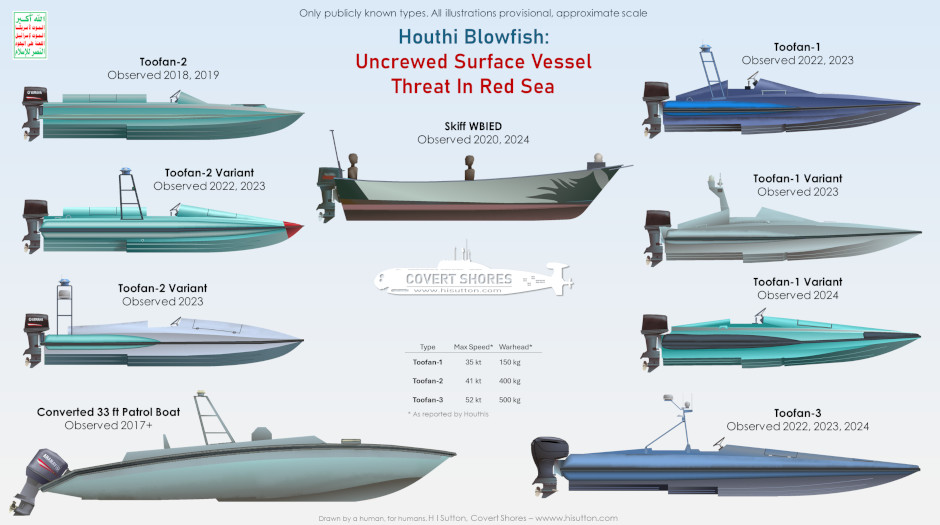Houthi's Blowfish: Guide To Explosive USV Threat In Red Sea
 The Houthi threat to shipping in the Red Sea sea lanes is being shaped by five threat vectors. Anti-ship ballistic missiles, anti-ship missiles, aerial drones, underwater drones, and surface drones. The latter, termed USVs (uncrewed surface vessels) present a particular threat. Recent attacks with USVs, such as the sinking of MV Tutor, have brought their threat to the fore.
The Houthi threat to shipping in the Red Sea sea lanes is being shaped by five threat vectors. Anti-ship ballistic missiles, anti-ship missiles, aerial drones, underwater drones, and surface drones. The latter, termed USVs (uncrewed surface vessels) present a particular threat. Recent attacks with USVs, such as the sinking of MV Tutor, have brought their threat to the fore.
This guide will describe the observed types of Houthi USV.
USVs generally carry a larger warhead which detonates at or close up the waterline. They are also generally able to target weak points on a ship where this can have the biggest impact, such as the engine compartment. Modern merchant ships are remarkably difficult to sink, but an immobilized one can then be hit with other weapons. The June 12 2024 attacks on MV Tutor illustrate this. The ship was hit in the stern by a USV, which ultimately led to the ship being abandoned. It was subsequently hit at least 3 more times with various weapons and sunk.
Important note on terminology: Houthi explosive boats are generally referred to as WBIEDs (water-borne improvised explosive devices). There are instances and contexts were this makes sense. But it is the language of the War on Terror, and can be emotive. This can be unhelpful when we look at them in the wider context of armed USVs (Uncrewed Surface Vessels). We do not describe Ukraine's maritime drones in the same terms even when they meet the criteria. While I used the WBIED label for the improvised designs, I avoid using it as a catch-all term. These are weaponized USVs, or OWA-UAVs (one way attack - uncrewed surface vessels) just like comparable designs being built in Ukraine, US, South Korea, Taiwan and so on.
Brief History
The original thinking and technology evidently came from Iran. The IRGC (Islamic Revolutionary Guard Corps) has been iterating explosive boats since the Iran-Iraq war. While it wasn’t known to operate uncrewed variants, the development was hardly a surprise. And this uncrewed technology was one of the first things supplied to the Houthi Movement in Yemen.
In the 2017-22 period these were primarily intended for use against the Saudi and UEA forces fighting the Houthis. Initially this took the form of kits which were used to convert ex-Yemeni Navy interceptor boats into explosive boats. Ironically the boats had originally been supplied by UAE, and now they were targeting UAE and its Saudi allies.


An attack on the Saudi frigate Al Madinah caused serious damage
There were several notably attacks which announced to the world the arrival of the uncrewed explosive boat. On Jan 30 2017 three were used in an attack on the Saudi frigate Al Madinah (702). The damage was serious, two crew members were killed and three injured, but the ship survived. Then on December 14 2020 Houthi USVs attacked the Saudi port of Jeddah. A Saudi axillary, Borida (902), was hit amidships on the starboard side, creating a large hole. A merchant ship, BW Rhine (IMO: 9341940), was also hit. Throughout this time several other attacks were unsuccessful or thwarted.
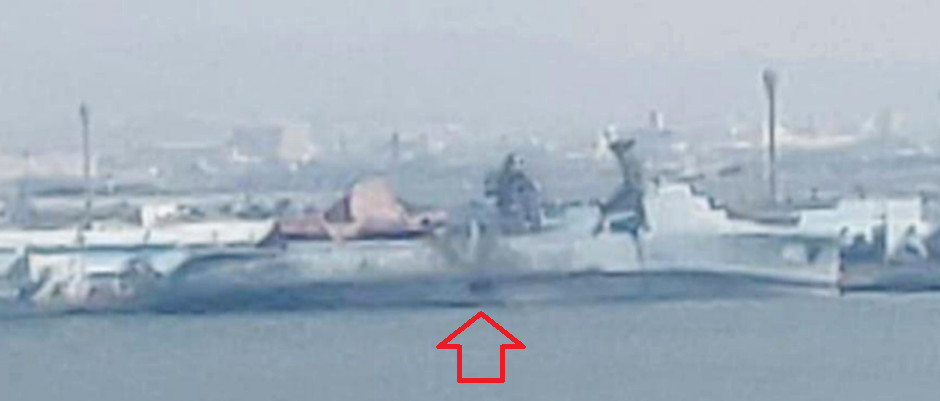
Boraida showing the hole caused by the explosive boat. The ship has been angled to port (left) to raise the hole higher above the water.
When the Houthi's turned their attention to international shipping transiting the Red Sea, the USVs became a key part of their arsenal.
Houthi USV Capabilities Compared To Ukraine's
Houthi USVs pose a significant threat to shipping, yet they lag behind the Ukrainian models in terms of technology and operations. Unlike the fully autonomous Ukrainian craft, Houthi USVs require a human pilot to navigate to the start line of the attack. After that the pilot transfers to another vessel. Consequently, these USVs retain a cockpit. Ukrainian types do not require space for a pilot because they are uncrewed throughout the entire mission.
The Houthis also rely on motherships, which tow the USVs on longer missions, pick up the pilots, and also provide command and control during the attack. This is a comparative weak point. The Ukrainian advantage lies in advanced communications, particularly StarLink, which allow remote control from hundreds or thousands of miles away.
Navies considering OWA-USVs should weigh the pros and cons of each model based on their specific needs. The Houthis' craft are less advanced, but do not rely on robust access to satellite communications.
1st Generation: Weaponized 33ft Patrol boats
The attack on the Saudi Frigate al Madinah in the southern Red Sea on January 29 2017 was carried out by a remotely operated explosive boat. The veesel is believed to have been a weaponized patrol boat, converted to uncrewed operations. These vessels are Water-Born Improvised Explosive Devices (WBIEDs) in the proper sense. They do however likely leverage conversion kits likely supplied by Iran. Captured examples, which appear consistent with one another, are conversions of 10 meter (33ft) boats made in by Al Fattan Ship Industry in UAE. According to Conflict Armament Research (CAR), the UAE donated 60 boats to Yemen before the outbreak of the war.
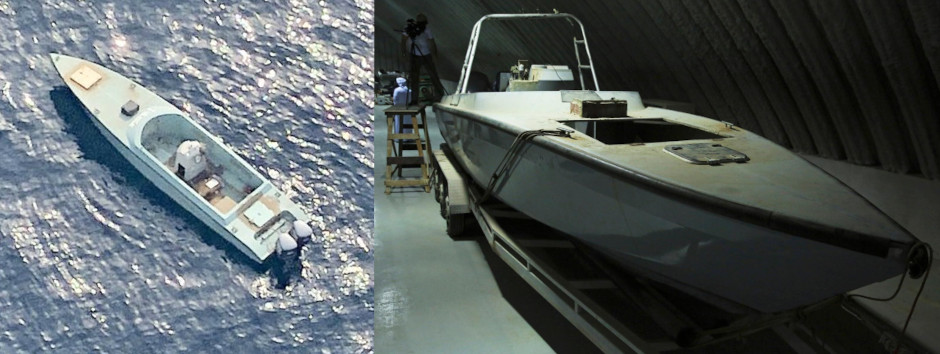
WBIED specifications
Length: 10 meters
Beam: 2.3 meters
Draft: 0.43 meters
Crew: n / a (originally 2-3 when crewed)
Speed: 45 knots maximum, 35 knots cruising
Propulsion: 2 x 200hp L200A Yamaha outboard motors with 165 US Gallons of fuel
Warhead: 1 x 454kg warhead from P-15 Termit (SS-N-2 STYX) anti-ship missile
On July 30 2017 a UAE Navy warship was partially sunk at the pier in Mocha. Few details are public, but a WBIED is believed to have been used.
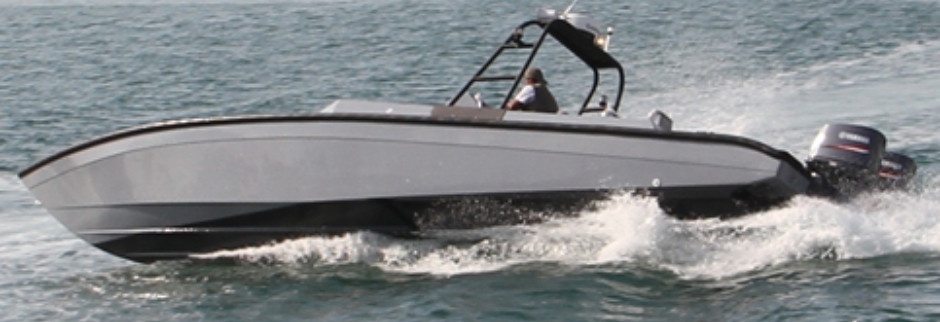
10 meter (33ft) patrol boat from Al Fattan Ship Industry, UAE
2nd Generation: Weaponized Skiffs
On March 4 2020 four WBEIDs attempted to attack an oil tanker 80 nautical miles off Yemen's southern coast. The vessels were not the converted patrol boats seen previously, but ordinary skiffs. These fishing vessels are constantly encountered in the region, making it an effective camouflage for the USV.
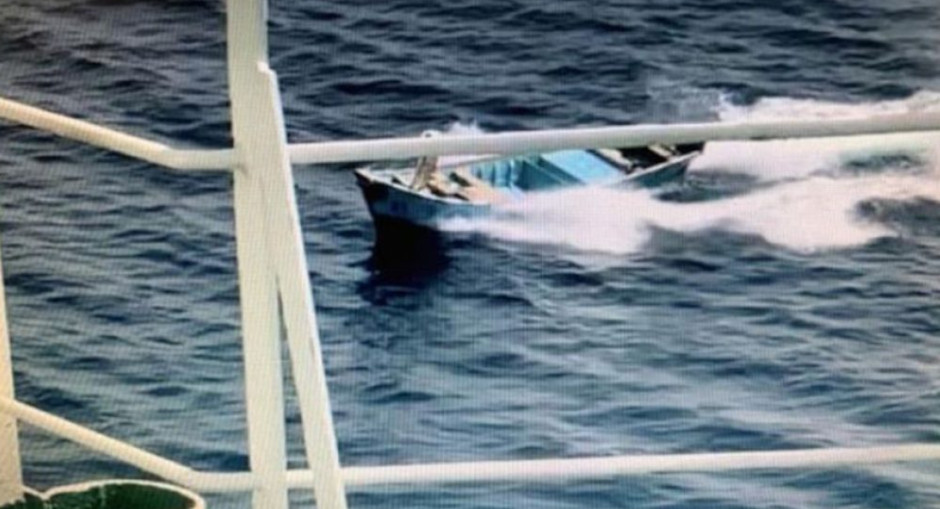
The uncrewed skiff attempting to attack a tanker, March 4 2020.
On June 12 2024 the merchant ship MV Tutor, was hit by a Houthi uncrewed skiff around 66 nautical miles southwest of Al Hudaydah, Yemen. The USV hit the stern of the ship, immobilizing it and causing flooding. One crew member is missing, assumed dead. The ship was subsequently abandoned and sunk after suffering more hits.
The USV was a converted fishing skiff, 5 - 7 metres in length. It appears to have mannequins to appear innocent at a distance.
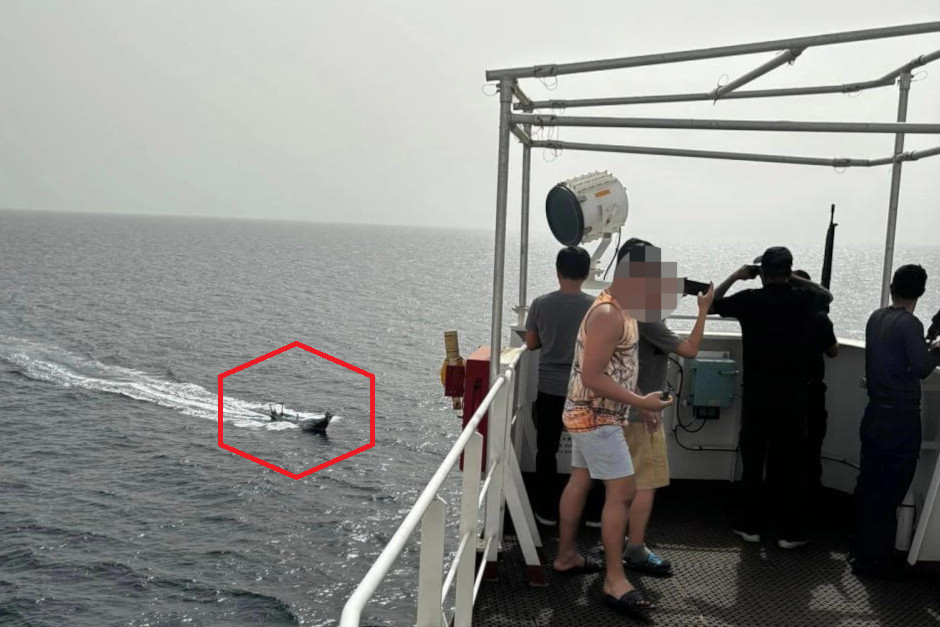
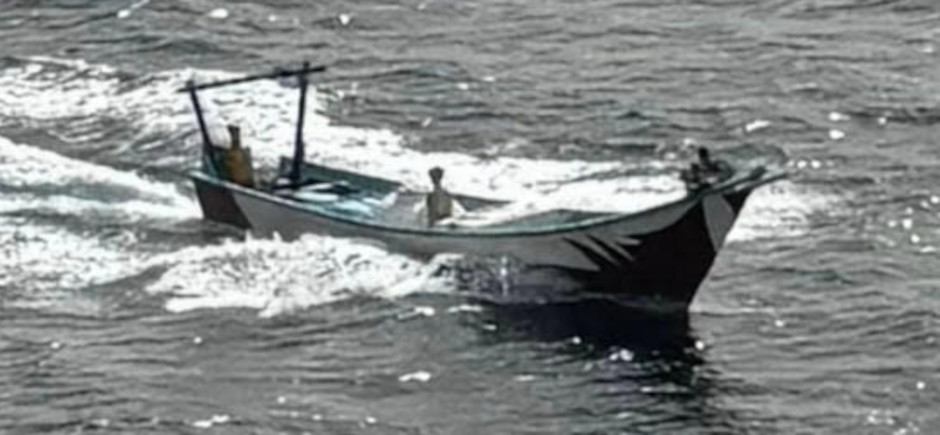
3rd Generation: BLOWFISH (Toofan)
The improvised boats were superseded by purpose-built designs. These are named Toofan (Devine wind) by the Houthis, and known to the Saudi/UAE forces with the reporting name BLOWFISH. These craft are well thought out and serially produced. There are three types, the Toofan-1, 2 & 3. Confusingly, this naming does not appear chronological. And there are distinct variants observed within each type. While there is clearly serial production, it appears to be small batches with significant variance between each. Possibly some are iterative improvement, but it may also reflect multiple workshops and engineers involved. A good analogy works be the classification of military canoes in World War Two. Many different makes and models were described as‘Canoe Mk.I’ based on their general characteristics rather than the details of the design. For Houthi Blowfish there is a distinct family look connecting all three types.
Toofan-2
The first observed type was the Toofan-2. On September 7 2018 Yemeni Government naval forces intercepted a Houthi forces unmanned surface vessel in the Red Sea. The craft was stopped and steered to a deserted beach, where it was reportedly later destroyed. A virtually identical example was discovered on July 8 2019. These craft are simple fiberglass hulls with an inflatable collar (which was deflated in both observed examples).
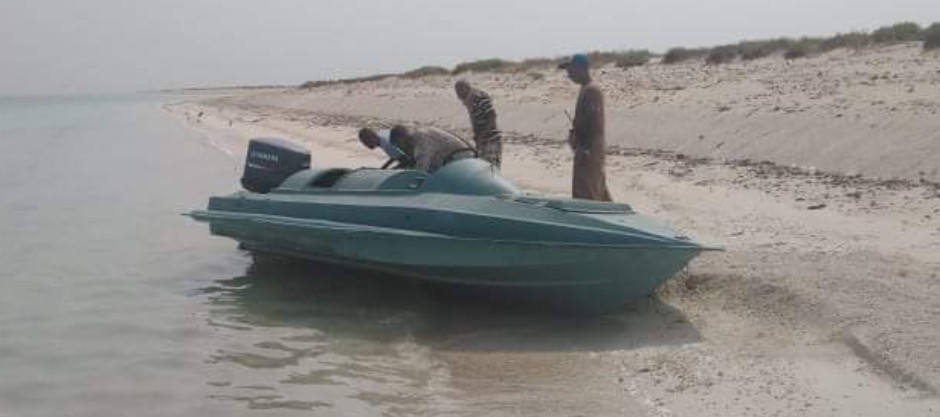

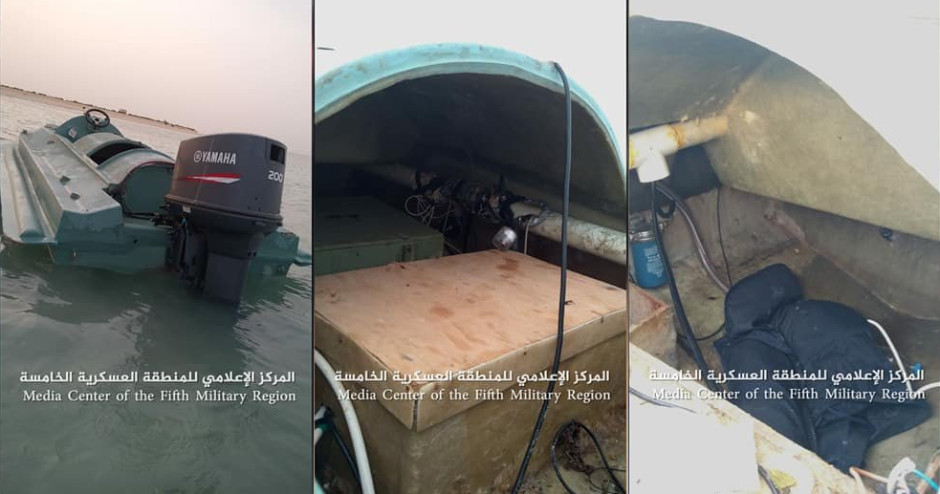
There is a cockpit in the center. There are two cargo holds, fore and aft of the cockpit. One or both of these is likely used to stow the warhead. In 2022 a slightly different variant was observed with a different upper profile. Then again in 2023 one was displayed in a military parade. This was overall similar but featured a detachable sensor mast fitted. These masts appear common to all three types of Toofan.
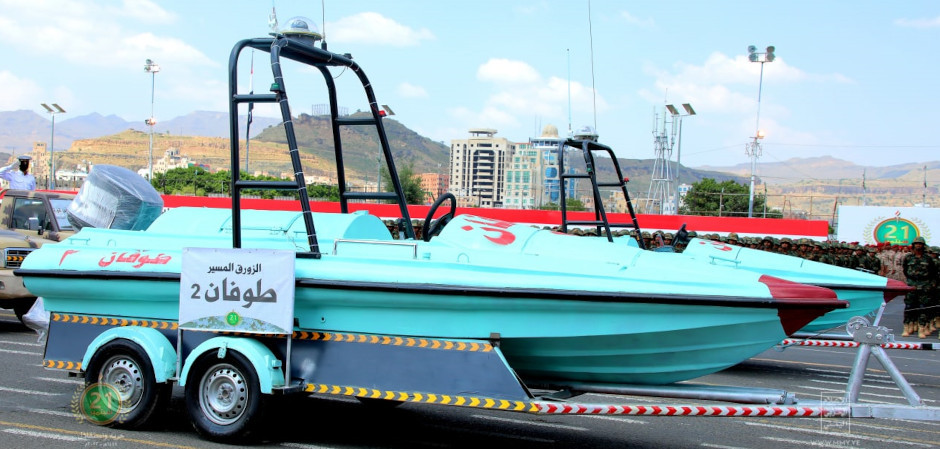
Toofan-2 on parade in 2023.
Toofan-2 Specifications:
Length: 5.28 m
Width: 2.44 m
Maximum Speed: 41 kt reported
Propulsion: 1 x 200hp Yamaha 2-stroke outboard.
Warhead: 400 kg
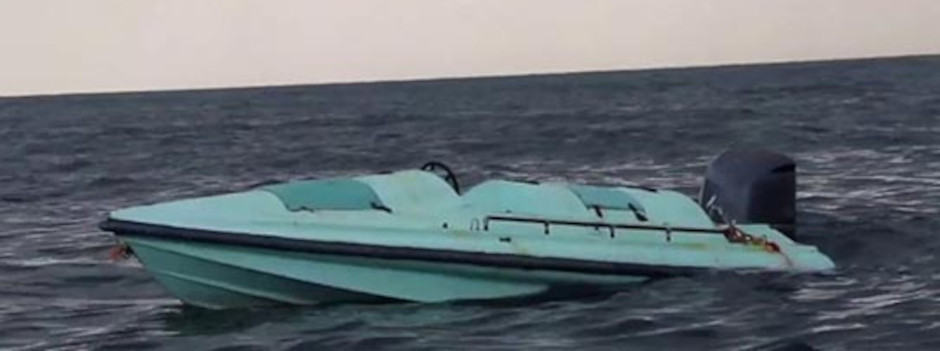
Toofan-1
Smaller than the Toofan-2, the -1 carries a 150kg warhead. The main visual identifier is the short length of the superstructure behind the cockpit.
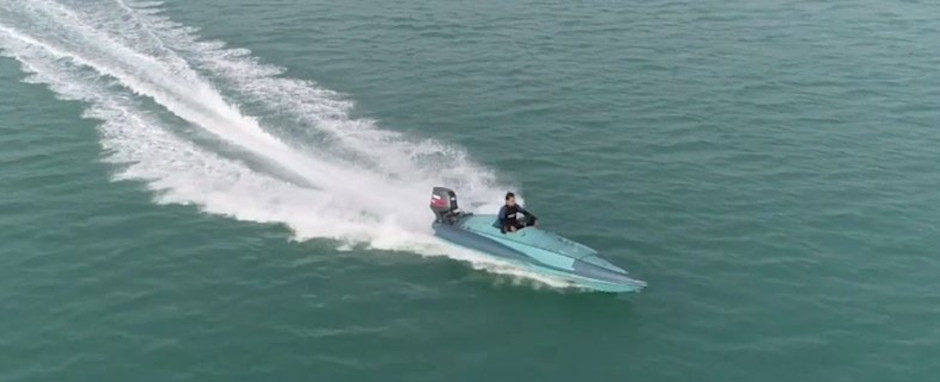
Toofan-1 from a promotional video published in June 2024.
Toofan-1 Specifications:
Maximum Speed: 35 kt reported
Propulsion: 1 x 200hp Yamaha 2-stroke outboard.
Warhead: 150 kg
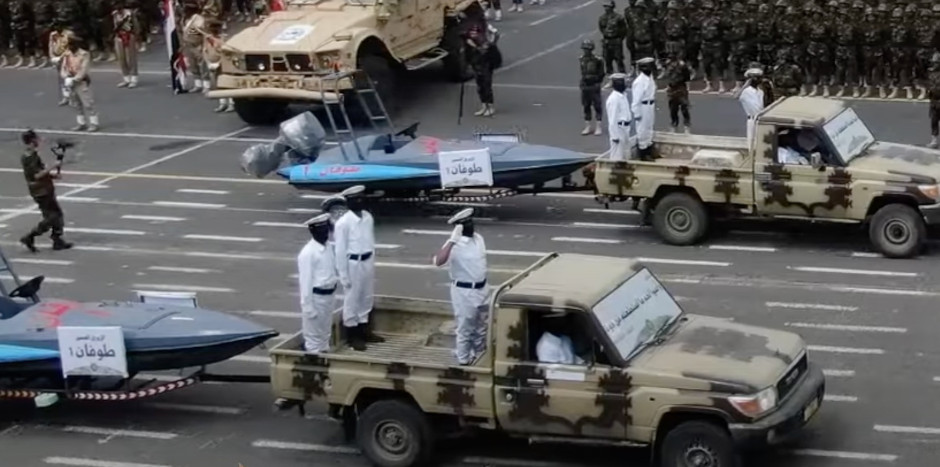
Toofan-1 observed during a military parade in Yemen on September 22 2022.
Toofan-3 / Toofan al-Mudammer
The largest of the Toofan family, this can carry a larger warhead. Other details are sparse.
Toofan-3 Specifications:
Maximum Speed: 52 kt reported
Warhead: 500 kg, but also claims of 1000 – 1500 kg
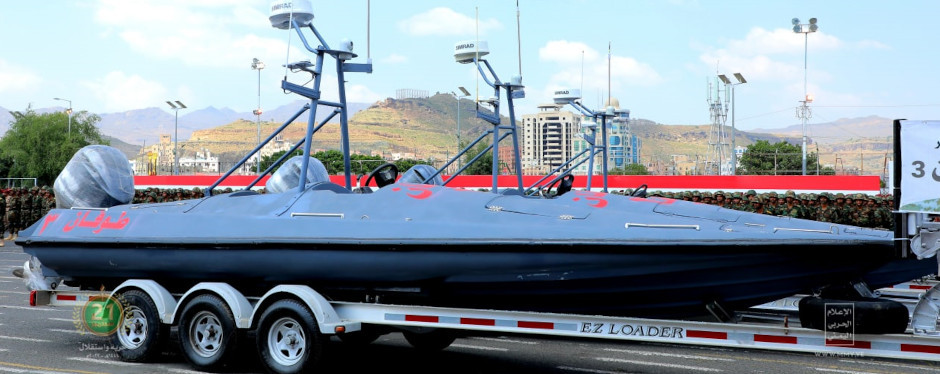
Toofan-3 on parade in 2023.
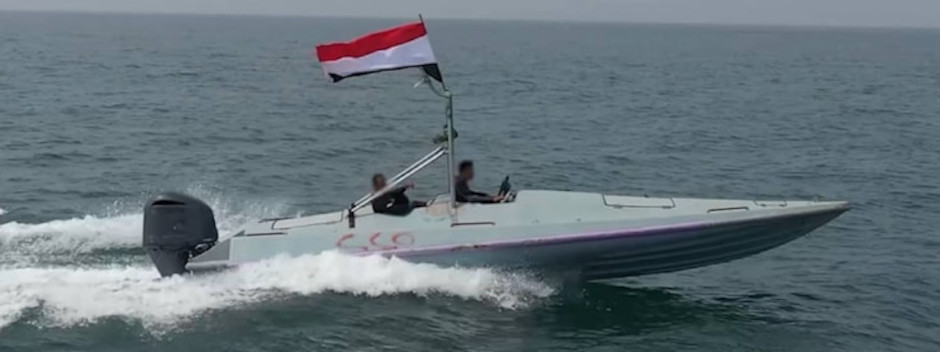
Related articles (Full index of popular Covert Shores articles)

 Ukraine's Marichka Underwater Drone (AUV)
Ukraine's Marichka Underwater Drone (AUV)

 Ukraine's Maritime Drones (USVs)
Ukraine's Maritime Drones (USVs)


 Taedong-B 'Kajami' ('Zulfikar') submersible boat w/Cutaway
Taedong-B 'Kajami' ('Zulfikar') submersible boat w/Cutaway
 Explosive Boats world history
Explosive Boats world history


